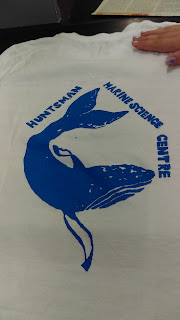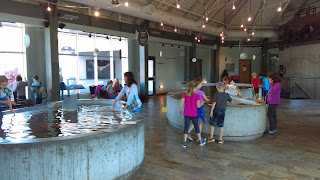The course included whale, seal and seabird watching on the Bay of Fundy with Quoddy Link Marine, studying plankton, aging porpoise teeth in the lab, touring the Huntsman Fundy Discovery Aquarium, learning to identify individual right whales, playing whale and seal communication games, visiting the bird banding station on campus, debating, and digging up a seal skeleton. Students also have the opportunity to explore and visit town, the beautiful St. Andrews by-the-Sea.
While taking the course participants stay on campus in our residences and eat in our dining hall. It is a truly immersive experience.
Here are a few pictures of our week.
Learning seal and whale terminology.
Touring the Huntsman Fundy Discovery Aquarium.
Working on a presentation about the minke whale.
Learning to identify right whales based on their callosities patterns.
Heading out onto the Bay of Fundy in search of marine mammals and seabirds.
Harbour and grey seals hauled out on Black Rock.
Grey seals in the water around Black Rock.
Looks comfy!
Stopped at White Horse Island to see the kittiwakes.
Black-legged kittiwakes on White Horse Island.
Kittiwake on a nest.
Guillemots
Razorbills
Harbour porpoise
Head Harbour Lighthouse on Campobello (also called East Quoddy Head).
Minke whale close to Campobello Island.
Minke whale
Old Sow off the tip of Deer Island.
Bonaparte's gull
Learning about bird banding.
Learning about seabird adaptations.
Day 2 on the Bay. Seals hauled out on Black Rock.
Note the differences in size of the harbour seals and the grey seal.
Note the blow of the fin whale.
Fin whales are the second largest whales in the world.
Fin whale dorsal.
Bald eagle on Pendleton Island.
Screening print keepsake t-shirts.
One of the beautiful t-shirts.
More information about this field course and others offered at the Huntsman can be found on our website or by calling 506-529-1200.


































































